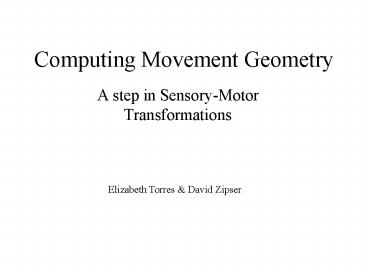Computing Movement Geometry - PowerPoint PPT Presentation
1 / 24
Title:
Computing Movement Geometry
Description:
Computing Movement Geometry A step in Sensory-Motor Transformations Elizabeth Torres & David Zipser Stuff that s easy in the Geometric Stage Geometric Stage Input ... – PowerPoint PPT presentation
Number of Views:41
Avg rating:3.0/5.0
Title: Computing Movement Geometry
1
Computing Movement Geometry
- A step in Sensory-Motor Transformations
Elizabeth Torres David Zipser
2
Sensory Input Kinematics
Motor output
3
Stuff thats easy in the Geometric Stage
- Specifying movement paths.
- Dealing with excess degrees of freedom.
- Some constraint satisfaction.
- Some error correction.
4
Geometric Stage Input -- OutputReaching to
Grasp with a Multi-jointed Arm
What goes on in here?
Represented as changes in joint angles
5
Gradient Descent
6
(No Transcript)
7
Joint Angles
8
(No Transcript)
9
Gradient Descent for Simulating Hand Translation
10
Reconfiguring Joint Angle Space
11
Orientation Matching
12
Distance function for translation and rotation
13
Experiments
14
G symmetrical and positive-definite
15
Speed Invariance of Movement Path
TARGET
One subject, one movement at each speed
16
Six subjects, six movements each
17
Co-articulation
18
Error Correction
19
Correcting error with retinal image feedback
Retina(s)
20
Discussion Break
21
The gradient of a sum the sum of the gradients
22
dq
Hidden Units
posture
target position
target orientation
23
Preferred Directions Rotate across External Space
24
(No Transcript)































